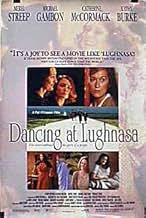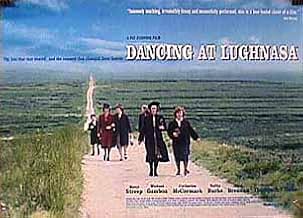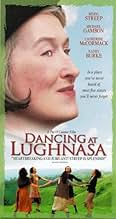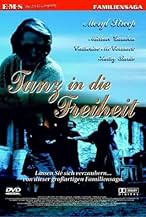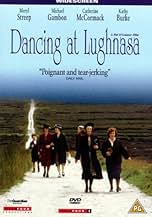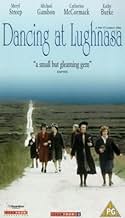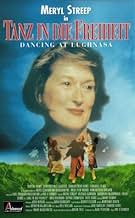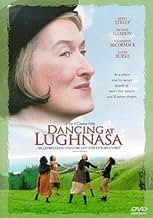NOTE IMDb
6,3/10
4,3 k
MA NOTE
Cinq sœurs célibataires tirent le meilleur parti de leur simple existence dans l'Irlande rurale des années 1930.Cinq sœurs célibataires tirent le meilleur parti de leur simple existence dans l'Irlande rurale des années 1930.Cinq sœurs célibataires tirent le meilleur parti de leur simple existence dans l'Irlande rurale des années 1930.
- Réalisation
- Scénario
- Casting principal
- Récompenses
- 2 victoires et 7 nominations au total
Avis à la une
... to enjoy this film. I had five Italian aunts and the insights into their sisterly relations appear to me spot on. So often in relationship stories, each character is a paragon of one virtue. Not true in "Dancing in Lughnasa" where the women are not prototypical but rather complex and totally unself-conscious individuals.
As one of the finest actors of her time, to her credit, Meryl Streep doesn't overpower the excellent ensemble cast. Even the men players, who are figuratively essential but literally superfluous to the survivl of this family, are presented as whole people. They are neither villains or heroes; just men. Go figure!
In a film that depends on the actors' considerable restraint in exposing the internal and external dramas of the plot, there are two wonderful moments of abandon near the end: the essential dances of life ... the dance of faith, hope and charity and the dance of decadenced, despair, and destruction.
An overall enjoyable entertainment, the film fails only in not giving the audience a better understanding of the implacable, irreversible outside forces in the world working against the family. This is film after all where we expect to be shown as well as told.
As one of the finest actors of her time, to her credit, Meryl Streep doesn't overpower the excellent ensemble cast. Even the men players, who are figuratively essential but literally superfluous to the survivl of this family, are presented as whole people. They are neither villains or heroes; just men. Go figure!
In a film that depends on the actors' considerable restraint in exposing the internal and external dramas of the plot, there are two wonderful moments of abandon near the end: the essential dances of life ... the dance of faith, hope and charity and the dance of decadenced, despair, and destruction.
An overall enjoyable entertainment, the film fails only in not giving the audience a better understanding of the implacable, irreversible outside forces in the world working against the family. This is film after all where we expect to be shown as well as told.
I wasn't really sure what to expect from this movie, since I had no idea what the play was about or anything. The only actor in the movie I had heard of was Meryl Streep, but that didn't matter because she was the reason I went to see the movie. As always, her accent was pitch perfect, right down to the Donegal vowels. Her performance was also incredible, which deserves some recognition but probably won't get any. The rest of the cast was also wonderful, particularly Sophie Thompson as Rose. If anyone else should get recognition, it should be her because her performance was heart-wrenching and bittersweet. So GO AND SEE IT!!! NOW!!
This movie was completely wonderful for every single moment. The cast is terrific from top to bottom; the cinematography is gorgeous, even the soundtrack is memorable. It is the type of movie where very little happens, but it does not matter a bit. The characters are intriguing enough to hold your interest. I do not know how Streep does it; I think her talent is limitless. Everyone else is great too. For 92 minutes you will forget everything else and if you can allow yourself, you will be swept away by this movie.
This movie version is pleasant enough but does not have the power of the stage play upon which it is based. Spoilt brat that I am, I saw the original production at the RNT in 1990 with the amazing Alec McCowen as Uncle Jack. I am a great fan of Michael Gambon, but he is simply miscast in that role for the movie. Not so Meryl Streep, who does a superb overpowering aunt. The delightful Catherine McCormack and Rhys Ifans do a good job of the love interest. This is nevertheless a shadow of the stage play. My better half liked it, but had not seen the stage version. For lovers of Irish drama the film is worth 90 minutes of your time.
Watchable but instantly forgettable film of Brian Friel's award-winning play which provides its greatest pleasures through the strong performances of its ensemble cast. Five independent-minded sisters living in Donegal in the mid 1930s face the possibility of change when economic and emotional circumstances conspire against them. The return of their brother from religious missions in Africa signals the beginning, and as the pagan festival of Lughnasa, which celebrates the harvest and forebodes the coming of winter, is celebrated around them, they must come to terms with changes in their own relatively comfortable middle class world. The ten year old son of one of them views events with a nostalgic eye which nonetheless sees the hardship and heartbreak which occurs around him.
Despite director Pat O'Connor's valiant attempts to open out' the play, the film is still extremely theatrical. The inclusion of landscape shots and the restaging of certain scenes in outdoor locations unavailable in the theatre does not really make the film cinematic. It merely adds visuals to what is still a complex series of linguistic exchanges which delineate and explore character. Authentic production design and costuming and the persistent presence of a traditional-themed score by Bill Whelan contribute to the feeling of the film, and with the help of good accent work by the cast, it manages to successfully evoke a feeling of time and place. However it remains an extremely well produced stage play on film, and is still bound by blocking and staging conventions which allow the actors to meet and greet one another to exchange their thoughts and feelings. The closest the film comes to a visual symbolic system is the use of dance and ritual to underscore the social and emotional tensions. The undercurrent of paganism which defines the relationships between people and their sense of the cosmos is constantly evoked (as it was in the play), and the film begins with a credit sequence featuring images of African tribes people in traditional costumes. But other than the climactic dance scene where the sisters celebrate their sisterhood to the strains of ceili music, the film rarely manages to escape the enclosed and cerebral world of the stage version.
But paradoxically, the reliance on actors plying their trade on well written words (rather than visuals) is the thing which saves the film from itself. Meryl Streep gives a convincing performance (and manages a creditable accent) as the repressed, authoritarian schoolteacher who heads the female clan, and she is more than matched by Michael Gambon's endearing performance as the slightly baffled priest whose exposure to the customs and rituals of Africa have coloured his perceptions of home. The rest of the cast (the non-stars, so to speak) are equally good, particularly Sophie Thompson as the simple minded Rose and Kathy Burke as the chain smoking Maggie. Catherine McCormack and Brid Brennan (the latter a veteran of the Abbey Theatre production) have less showy roles, but work distinctive characterisations in with those of the others with ease and skill. Supporting male performances from Rhys Ifans and young Darrell Johnston are also good, and the film also comes with a rich voice over provided by Gerard McSorley (who played the part of the the child at an adult remembering in the stage version).
This aspect of the film alone is probably worth the time and attention required to view it, but on the whole it is a less rewarding experience than the play itself. While an unfair basis upon which to criticise a work of adaptation, the material was perhaps fundamentally unsuited to cinematic treatment. Though Frank McGuinness has done his best to translate the themes and character issues, and has successfully done so insofar as it applies to theme and character, this is not so much a film version as a film of the play with some additional settings and scenes which prevent it from becoming completely unwatchable. What power it has comes from the power of the play, and it is mostly evinced at the level of verbal discourse. Theatrical adaptation is a minefield for film makers and has produced varying results in the past. Dancing at Lughnasa does not distinguish itself in the annals of this sub-section of film history, but for those patient enough with its lack of genuine cinematic interest, it offers certain pleasures which should pass the time painlessly enough.
Despite director Pat O'Connor's valiant attempts to open out' the play, the film is still extremely theatrical. The inclusion of landscape shots and the restaging of certain scenes in outdoor locations unavailable in the theatre does not really make the film cinematic. It merely adds visuals to what is still a complex series of linguistic exchanges which delineate and explore character. Authentic production design and costuming and the persistent presence of a traditional-themed score by Bill Whelan contribute to the feeling of the film, and with the help of good accent work by the cast, it manages to successfully evoke a feeling of time and place. However it remains an extremely well produced stage play on film, and is still bound by blocking and staging conventions which allow the actors to meet and greet one another to exchange their thoughts and feelings. The closest the film comes to a visual symbolic system is the use of dance and ritual to underscore the social and emotional tensions. The undercurrent of paganism which defines the relationships between people and their sense of the cosmos is constantly evoked (as it was in the play), and the film begins with a credit sequence featuring images of African tribes people in traditional costumes. But other than the climactic dance scene where the sisters celebrate their sisterhood to the strains of ceili music, the film rarely manages to escape the enclosed and cerebral world of the stage version.
But paradoxically, the reliance on actors plying their trade on well written words (rather than visuals) is the thing which saves the film from itself. Meryl Streep gives a convincing performance (and manages a creditable accent) as the repressed, authoritarian schoolteacher who heads the female clan, and she is more than matched by Michael Gambon's endearing performance as the slightly baffled priest whose exposure to the customs and rituals of Africa have coloured his perceptions of home. The rest of the cast (the non-stars, so to speak) are equally good, particularly Sophie Thompson as the simple minded Rose and Kathy Burke as the chain smoking Maggie. Catherine McCormack and Brid Brennan (the latter a veteran of the Abbey Theatre production) have less showy roles, but work distinctive characterisations in with those of the others with ease and skill. Supporting male performances from Rhys Ifans and young Darrell Johnston are also good, and the film also comes with a rich voice over provided by Gerard McSorley (who played the part of the the child at an adult remembering in the stage version).
This aspect of the film alone is probably worth the time and attention required to view it, but on the whole it is a less rewarding experience than the play itself. While an unfair basis upon which to criticise a work of adaptation, the material was perhaps fundamentally unsuited to cinematic treatment. Though Frank McGuinness has done his best to translate the themes and character issues, and has successfully done so insofar as it applies to theme and character, this is not so much a film version as a film of the play with some additional settings and scenes which prevent it from becoming completely unwatchable. What power it has comes from the power of the play, and it is mostly evinced at the level of verbal discourse. Theatrical adaptation is a minefield for film makers and has produced varying results in the past. Dancing at Lughnasa does not distinguish itself in the annals of this sub-section of film history, but for those patient enough with its lack of genuine cinematic interest, it offers certain pleasures which should pass the time painlessly enough.
Le saviez-vous
- AnecdotesOriginal choices to star were Frances McDormand and Kate Winslet.
- GaffesThe radio is one of the first ever made, so it's a tube radio, which would not be able to come on instantly like the later transistor radios; it would have needed a while to warm up before there would be any sound from it.
- Citations
Kate 'Kit' Mundy: I am a righteous bitch, amn't I?
- Crédits fousDuring the opening credits, stills of African tribal dances and of Jack as priest in Africa are shown.
Meilleurs choix
Connectez-vous pour évaluer et suivre la liste de favoris afin de recevoir des recommandations personnalisées
- How long is Dancing at Lughnasa?Alimenté par Alexa
- What is 'Dancing at Lughnasa' about?
- Is this film based on a book?
- What is "Lughnasa"?
Détails
- Date de sortie
- Pays d’origine
- Site officiel
- Langue
- Aussi connu sous le nom de
- Strange Darling
- Lieux de tournage
- Sociétés de production
- Voir plus de crédits d'entreprise sur IMDbPro
Box-office
- Montant brut aux États-Unis et au Canada
- 2 287 818 $US
- Week-end de sortie aux États-Unis et au Canada
- 83 759 $US
- 15 nov. 1998
- Montant brut mondial
- 2 287 818 $US
- Durée1 heure 35 minutes
- Couleur
- Mixage
- Rapport de forme
- 1.85 : 1
Contribuer à cette page
Suggérer une modification ou ajouter du contenu manquant

Lacune principale
By what name was Les moissons d'Irlande (1998) officially released in India in English?
Répondre

